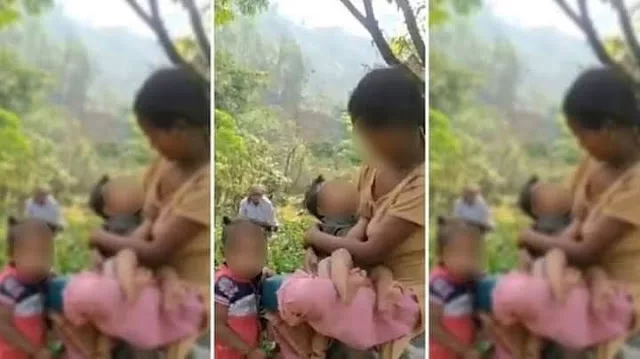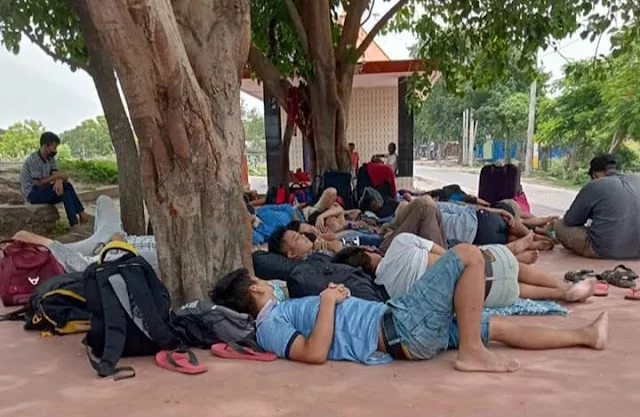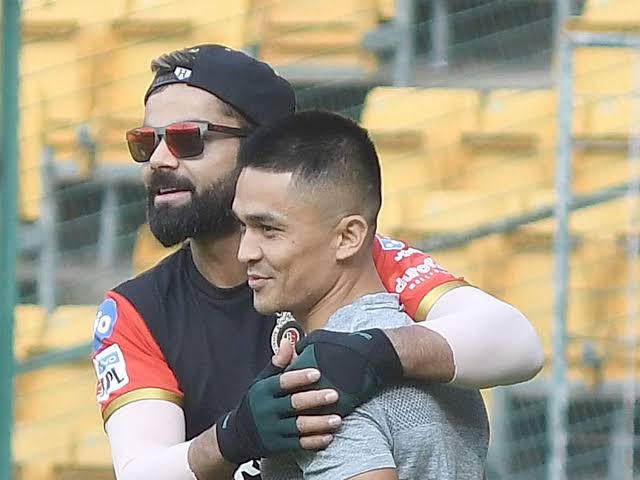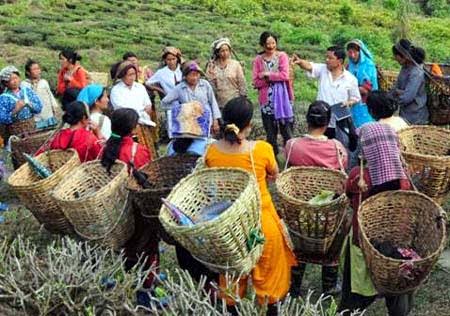One was humor, second, easy-to-sing and pick-up songs in melodious tunes and the third, the usage of simple Nepali householders‟ language. Thus, instead of sermonising in seriously, Mitrasen Thapa used the medium of humour, drama, singing and dance. His songs first mesmerised the audience who then continued to sing them again and again. The messages got repeated in the process. Mitrasen realised the community needed to come together and get united all across. Through his creative work in the Nepali language and travelling, Mitrasen united all Gorkhas from Nepal to Darjeeling to Punjab. Mitrasen also highlighted the weaknesses of the society which could affect the future. He wrote against extravagant living and excesses of drinking.
 |
| Master Mitrasen Thapa Magar Indian Gorkha folk singer, lyrics writer, dramatist, social worker and a Freedom Fighter who took part in World War-I |
He wrote about the upliftment of women, and also the importance of high thinking and simple living. He wrote and spread in Nepali, the messages of Gautam Buddha, Bhagvad Gita and Mahabaharata for the Nepali masses to understand and imbibe in their daily lives.. He was always concerned about the quality of the Nepali society and most of his works are dedicated to the people. Instead of sermonising in serious tunes, Mitrasen Thapa used humour, drama, singing and dance to communicate his messages. There was time when everybody from Darjeeling, Sikkim, Dehradun to Dharamshala was all singing Master Mitrasen Thapa‟s songs. This was his way of uniting them all. It is said that during his travels, he found Nepalis speaking different dialects, along with the highly Sanskritised Nepali bhasha. He realised that he had to develop a simple common man‟s Nepali language which could be understood by all. He then decided to write in simple Gorkhali, easily understood by all. Like they say the proof of the pudding is in the eating.
Lahure Ko Relimai – Master Mitrasen Thapa
Today as our society stands at crossroads, a revival of Master Mitrasen‟s works will again create the same magic. Nine of his songs are there recorded in his own voice and with his own music group. His writings have been compiled by several authors. 35 of his original Pandulipis are there. Out of which only a few have been published. A museum has been dedicated to him at his residence „Mitra Jhupro‟ in Totarani, Dharamshala /Bhagsu. The museum could do with funds and management for better care, but nevertheless it still houses his work, his costumes, his stage jewellery, his harmonium, his medals and all that he possessed in his humble life of fifty years. It is painstakingly run alone by his only daughter-in-law Smt Devkanya Devi Thapa, widow of Master Mitrsen‟s only son Late Digvijay Singh.
Her message this morning to me was “Jole Mitrasen Thapa lai prem garcha unsang yehi vinti chha.. Unko Jyot hamesha jali rahos. Yo jo mitra jhupro chha yo hamesha chamchama rahos. Ma ta aba pachharti saal ko chhu. Ekley sambhali rahu chhu. Roj Dhoopbatti jalai dinchu. Saal ma ek baari unko janam din ma sabai la khana khilai dinchu. Aru ma kya kari sakhum? ” (Those who love Master Mitrasen Thapa, should ensure that the light of the flame of his work continues)
Extracts translated from some of the books written on Master Mitrasen Thapa
1) Mitrasen: A monograph by Magan Pathik on the Nepali author. Sahitya Academy, New Delhi (1994). First edition 1989. Second edition 1994. Amongst the many Gorkhas who made major contributions to Gorkha society was Master Mitrasen Thapa. Magan „Pathik‟of Dharamshala in his Bhartiya Sahitya Academy published book „Mitrasen‟, hails Mitrasen‟s lifetime as the golden period of Indian Nepali literature history. During this time, the country was astir with spiritual, social and political thinking. After the contributions of Vivekananda, Ramtirth and Lokmanya Tilak, great men like Gandhi‟s non-violence Satyagraha made a major impact on people. These great people were very inspiring to the people.
Rabindranth Tagore, Saratchandra, Jayshankar Prasad, Maithilisharan, Premchand, Dr Iqbal, Hasrat Muradabadi, Akbar Illhabadi and Josh Malihabadi, etc are considered the blessings of this time period, to the world of literature in the languages of Bangla, Hindi and Urdu. During that time the writers of the Nepali language included Dharnidhar Sharma, Surya Vikram Gewali, Paras Mani Pradhan, Thakur Chandra Singh, Bahadur Singh Baral and
2) Master Mitrasen ko Sanchhipt Parichay by Trilok Singh Thapa Magar, Master Mitrasen Thapa Smriti Pratisthan, Kathmandu. Family background: Enriched with Multitalented virtuoso, Master Mitra Thapa Magar was born on 29th December 1895 in India, Himachal Pradesh, Kangra District, Bhagsu Dharamshala, village Dhaarakhola. He is a Sijali Magar. His original home is from Western Nepal, earlier Banglung (now Parbat zilla), and Rakhupulla village. It is said that his grandfather Santsen Thapa (Santu Thapa) in the 18th century, came via Kumaon, Garhwal and Dehradun, to Bhagsu.
After military commander Amar Singh Thapa returned to Nepal, many Gorkhali soldiers settled near the Kangra fort area. Here was born Manver Sen Thapa Magar. Mitrasen was the son of Manversen Thapa and Radha Thapa. Despite born and brought up in India, Mitrasen has made great contribution to Nepal and Nepali language through his literature, folksongs, folk theatre, and folk lore. In 1936, he started wearing Nepali daura suruwal to create awareness of the Nepali dress. He was a great writer, director, actor, singer and producer. Nepali theatre and diary writing, humour and travel writing Mitrasen‟s contribution have been hailed as immortal.
Brief life history:
Master Mitrasen studied till class 8 in the Urdu medium as was the medium then in the Himachal schools. At a young age he also learnt music. From 1912 till 1920, he joined the 1st/1st Gorkha Rifles as per family tradition. During the 1st World War he was engaged in operations in Europe and Africa. The war‟s blood, gore, violence and hatred touched his soft heart. He entertained them with hare, rode, swarthy, Baja, chudka, played with his harmonium. Maruni dance, Phusungay dance, Horitakko phaag-dance. Being of creative bend, he was not much interested in his signalling work.
In 1914, he went with his troops to France and reached the island of St Marseilles. After one year, his troops reached Mesopotamia. There they fought against the Turk army for three years (1916-18). In the WW, lakhs of people died. Lakhs of people got injured. They included many of his friends. Therefore on returning from abroad, he resigned from the army in 1920. After that he devoted himself completely to the spread of the Nepali language through the mediums of plays, story writing, drama performances, social reforms and spread of dharma for the next 24 years of his life.
Nepal Tour In 1933-35
Mitrasen undertook a long tour of Nepal and different parts of India. First he reached his family home in Nepal at Banglung. After seeing the social condition there his work is seen to have veered towards jaati sudhaar and social reformation. Towards the end of 1933, he travelled through Palpa, Gulmi and Kathmandu. With a troupe of six members he presented his prowess in drama. Then he took the same troupe and reached Calcutta. There he recorded his plays “Dhuv” “Draupadi Charitraharan” on gramophone. In 1936, while touring Kathmandu, he advised Master Ratnadas and Melva Devi that music should have Nepaliness. His last trip to Nepal was in year 1944.
At that time Folk Theatre In 1936, Master Mitrasen established the Himalayan Theatrical Company. He performed in Hindi, Urdu and Nepali plays and earned name and fame. In Nepali language, his famous unrecorded plays are „Satyawadi Raja Harishchandra (8 parts), „Satyavaan Savitri‟, etc. In Hindi and Urdu, his works include plays „Badshah Tower‟, „Darde Jigar‟, „Noor kin Putli‟, „Mashoor ki Hoor‟, etc.
Nepali Folk songs He performed in the Kathmandu‟s durbar plays, dramas, songs and shamans. He was highly felicitated for the same.
Gramophone Disc Records (Recorded in Calcutta)
1) Malai khukrukkay paryo jethan timro bahini le.
2) Dhaan ko Bala jhulyo hazoor deshei ramailo
3) Lahureko reli ma pheshun ramrod
4) Aba ta jau kanchhi ghara, baato chha Ukali Ourahli
5) Bhana Gorkhali Daju bhai Jai Gorkhali
6) Swami na jao chhari bidesh
7) Kina garchha tanataani dui din ko chha jindagani
8) Chui chui chukiney jootta
9) Chhatre topi dhalkai dhalkayi khukri chamkayi Out of his 63 songs, only 23 have been recorded.
In 1942, he wrote the „Buddhvaani‟ in Nepali language to spread the message of the
Buddha in a simple language. From 1940 till 1944, he wrote in Nepali, „Tirth Yatra‟, „Dharma Chhora‟, „Premma Bhagwan‟, „Teen Kura‟, „Teen Yogi‟, etc. „Premma Bhagwan‟ 3) Mitra ko Diary This edition contains Epics „Mahabharat ko Prahlad‟, „Parshuram Lakshman Samvad (73 lines)‟, „Bhakt Prahlad (702 lines), „Chandra Haas (107 lines), „Veer Abhimanyu (1120 lines), etc. For women‟s emancipation he wrote „Ekadashi Vratkatha (142 lines)‟, „Satyanarayan Katha (245 lines)‟, „Vitwamagal (1760 lines)‟, „Chandra hans (170 lines) and „Sant Sukhvai (330 lines), etc
Song writing: Master Mitrasen wrote his songs in a simple language which would reach the Gorkhali masses.
For example: “Rajya Sukh bhog Nimti Phaaakeyma, yudh rachaune kina? Mero manle mandayina, Krishna sansar dubauna kina? Duniyalai kasth, dukh diyara garib ko ragat choosera Jansamuhlai masera mauz urauna kina?” Mahabharat In 1934-37 he wrote from the Mahabharat „Aadiparva‟, „Sabhaparva‟, „Viraat parrva‟, „Udyog parva‟in Nepali. 4) Buddha Baani by Master Mitrasen Thapa This book was published in 1996 by the Mitrasen Sahitya Sangeet Sabha, Bhagsu, Dharamshala, Himachal Pradesh, India with foreword by His Holiness.
( by Jyoti Thapa Mani)





